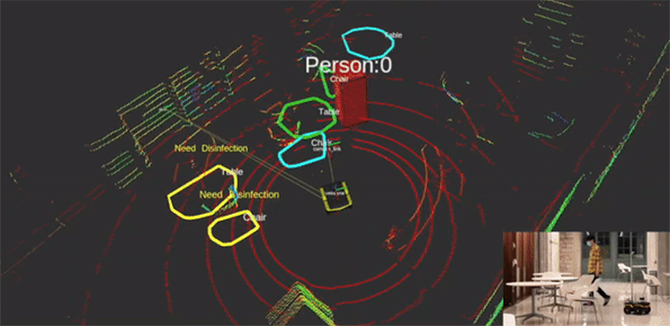Building an Autonomous Disinfecting Robot to Fight COVID-19
Shangzhou Ye (MSR '20) built a disinfection robot with perception, localization, mapping, and navigation capability for his final project in Northwestern Engineering's Master of Science in Robotics (MSR) program.

The COVID-19 pandemic forced people to re-evaluate certain cleaning routines. Thorough hand washing was shown to be a vital defense tactic against the spread of the novel coronavirus, as was consistent cleaning of commonly used surfaces, outlined by the Centers for Disease Control and Prevention (CDC). For his final project in Northwestern Engineering's Master of Science in Robotics (MSR) program, Shangzhou Ye (MSR '20) wondered if a robot could effectively clean and disinfect these surfaces as an efficient alternative to humans.
"Disinfecting surfaces of tables and chairs on a regular basis has become a new cleaning routine to reduce the spread of the virus in an indoor environment," Ye said. "Having such a robot that can automatically do the disinfection work when needed can possibly minimize the risk of cross-infection, and reduce the operating cost."
For his project, Ye developed a disinfection robot with perception, localization, mapping, and navigation capability. The robot can classify and localize tables, desks, and chairs in an indoor environment, as well as detect and track people three dimensionally. After a table, desk, or chair is used, the robot is designed to approach it and (theoretically) disinfect it. His vision was that a robot like this could improve the sanitary conditions and potentially be integrated into the regular cleaning cycle for all types of indoor environments, including hospitals, schools, and transportation stations.
Beyond the social good this type of robot could perform, what Ye enjoyed about the project was implementing lessons he learned in MSR. In Embedded Systems in Robotics during his first quarter in the program, Ye was introduced to the Robot Operating System (ROS), an essential tool for robotics software development. As part of his winter project, Ye built a simultaneous localization and mapping system from scratch. In his Deep Learning course, he learned how to train and deploy a model that fits a specific application.
He also benefited from daily interactions with students and faculty in the Center for Robotics and Biosystems.
The biggest challenge Ye faced was determining how to have the robot understand its surroundings using its available sensors and limited computation power. Before being able to patrol and disinfect an indoor environment, the robot needs to know where all the tables and chairs are located. His initial goal was to use a 3D-LiDAR system to identify and localize all objects. He tried implementing a deep learning model that used point-cloud data only, but his results were not as accurate or reliable as he hoped.
Instead, Ye fused data from camera images and 3D-LiDAR together. The robot segments each object in 2D and then localizes their position in 3D using point-cloud algorithms. He also set up a local network so the robot could run its deep learning model on a graphics processing unit in the cloud and accelerate the process.
"Interacting with real robots and sensors is much more than implementing algorithms or working in controlled environments in simulations," Ye said. "There are questions like how to achieve real-time performance with the limited computing resource, how to enable networking between multiple machines, and how to deal with unknown and dynamic scenes. I believe the experience of attempting to solve these problems is beneficial for my future career as a roboticist."
Today, Ye is a computer vision engineer for the self-driving wing of Rivian, a company that has already launched an all-electric truck and SUV. He's incorporating the lessons learned in MSR, particularly his work on the autonomous disinfection robot. He's heard concerns about the role robots will play in the future, and while he's not worried about humans losing ground to robots, he does think his final project offers a glimpse at how robots can help humans — and keep them safe in the process.
"Although robots are not going to match human intelligence in the near future, it is possible to design a robot that can handle a specific application very well using the current technology, and doing disinfection is one of them," Ye said. "I believe there will be more robots of this kind in production in the near future."

